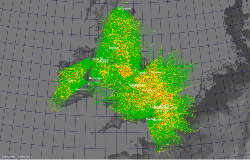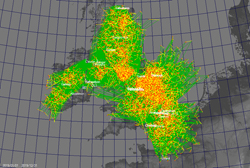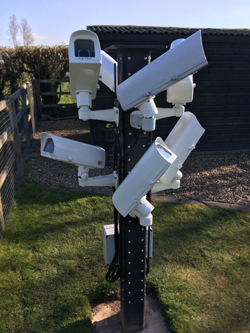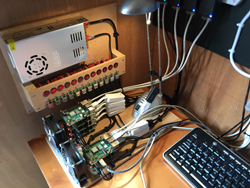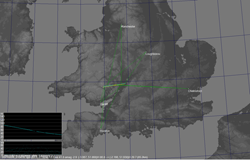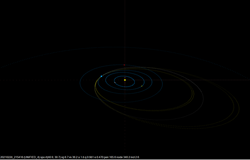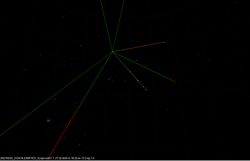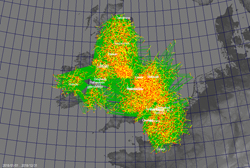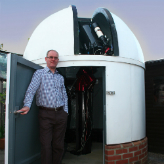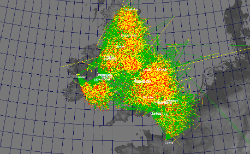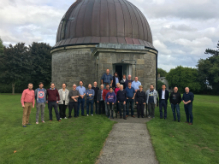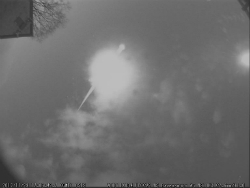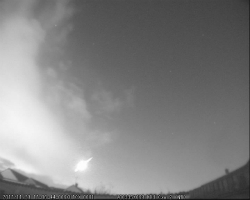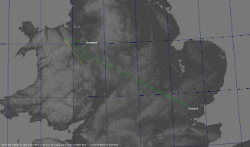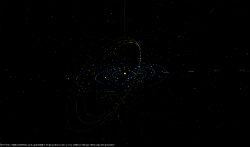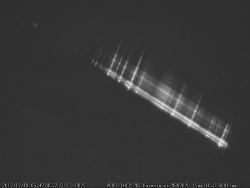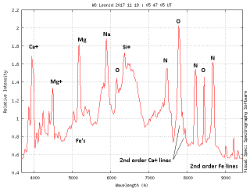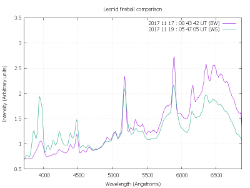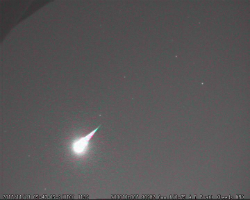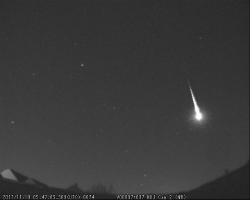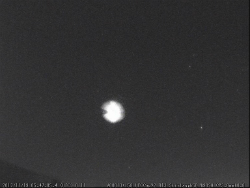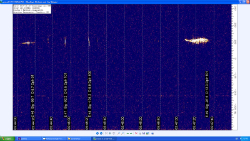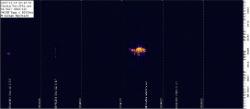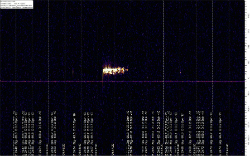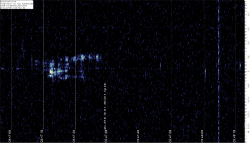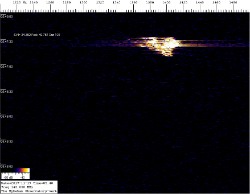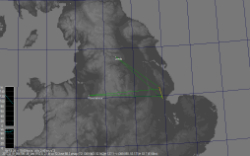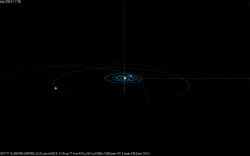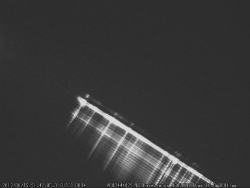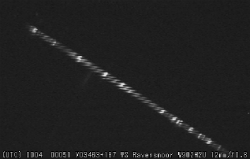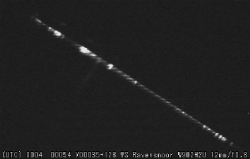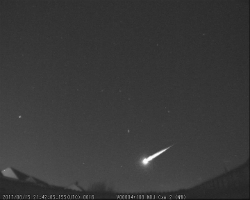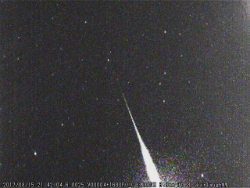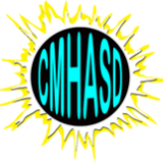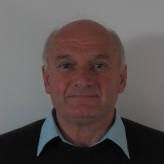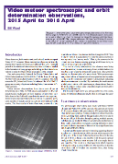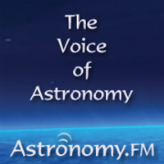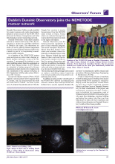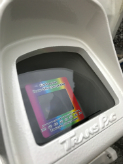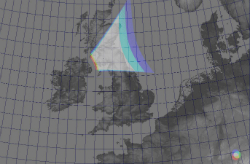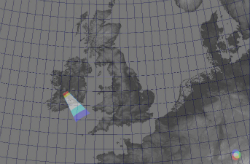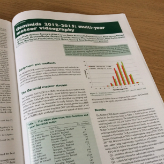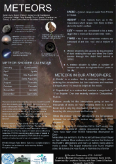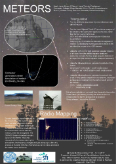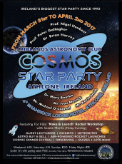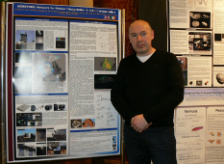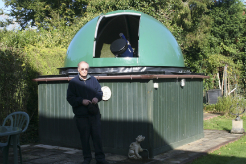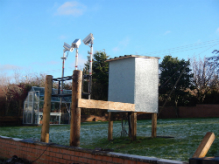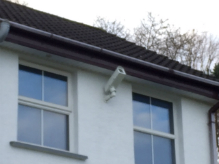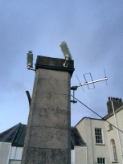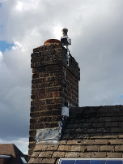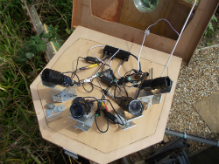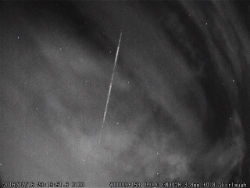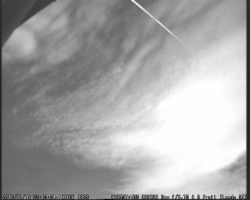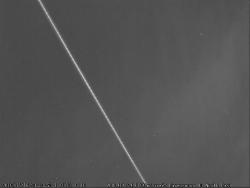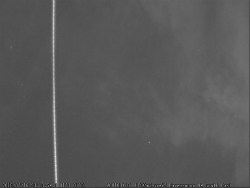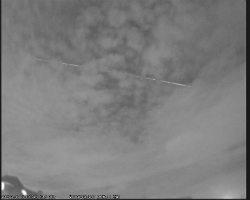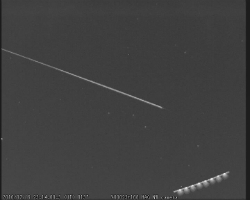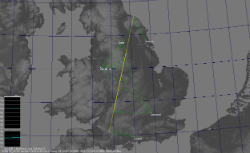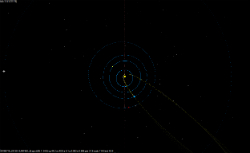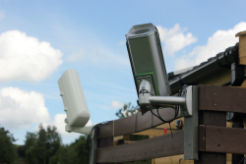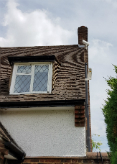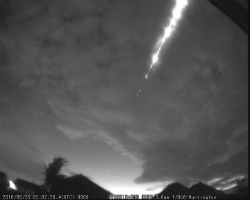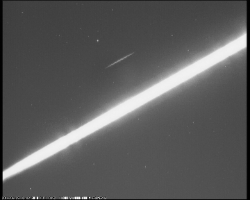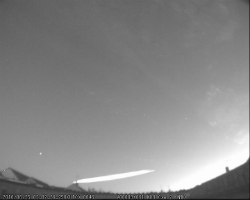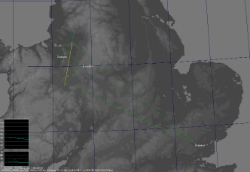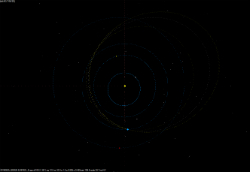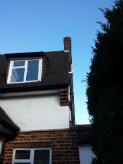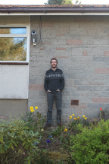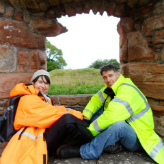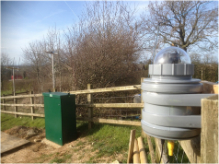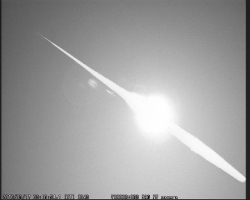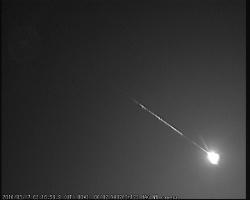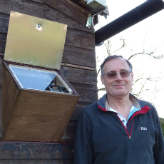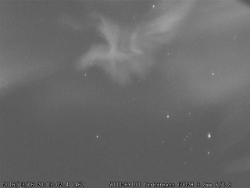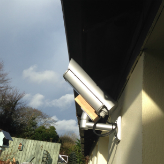Welcome to NEMETODE
Network for Meteor
Triangulation and Orbit Determination
Home
NEMETODE is a network of cameras based in the British Isles that monitor the night sky for meteors ("shooting stars"). Through the use of triangulation and timing the network is able to determine the actual trajectory and velocity of the meteoroids as they pass through the Earth's atmosphere. From this we are able to determine specific characteristics such as the radiant (that point in the sky from which each meteor appears to originate), how the position of this radiant varies with time and the parameters of the original solar orbit of the meteoroid (before the earth got in the way). We analyse our own data as we find this is an excellent feedback mechanism that deepens our understanding of the subject and enables us to optimise our detection capabilities. Our results are published in peer reviewed journals such as the Journal of the British Astronomical Association and WGN, the Journal of the International Meteor Organisation. Having completed our analysis, our data is uploaded to EDMOND for consolidation with other European groups. While we have excellent coverage over certain parts of the British Isles, there are still many gaps so please get in touch if you are interested in joining the group.
013th June 2021: 2020 Dataset: The partial 2020 NEMETODE dataset is now available. Thanks to all the observers who not only captured the data but also analysed it. Thanks too to Alex Pratt for consolidating all the files into the annual master. As ever, the datasets from earlier years are available for download via the Scientific Results page. Some members of the team are still analysing their 2020 data so the full-year results are not yet ready to publish ... however we hope to do so soon. Stay tuned!
09th April 2021: 2019 Dataset: The 2019 NEMETODE dataset is now available. Thanks to all the observers who not only captured the data but also analysed it. Thanks too to Alex Pratt for consolidating all the files into the annual master. Update 10th April 2021: We inadvertently omitted Adam Jeffers data (apologies Adam!) when compiling the full year dataset. The oversight has now been corrected! As ever, the datasets from earlier years are available for download via the Scientific Results page. Some members of the team are still analysing their 2020 data so the full-year results are not yet ready to publish ... however we do hope to publish a partilal dataset soon. Stay tuned!
08th April 2021: Building your own GMN Camera(s): Further to the details over on the Global Meteor Network website, Alex Pratt has collated a number of very useful hints, tips and links to help get you up and running should you choose to BYO GMN Camera. The build and configuration is very straightforward and as noted below, the NEMETODE team now have extensive hands-on experience should you still have any questions. Check out Technical Note #5 for details and please get in touch if you still have any questions.
07th April 2021: Meteor Prospects for the Next 12 Months: For those of you interested in understanding meteor prospects for the coming year then Tracie Heywood has it covered with her excellent "Meteor Activity" overview for The Astronomer. Defintitely worth a read and I know I'll be bookmarking it for future reference! Thanks Tracie, great job!
05th April 2021: Next Generation Camera Systems: Since first coming online back in 2010, almost all of the cameras in the NEMETODE Network have been based on the Watec 902 or 910 series cameras fitted with ultra-fast fast lenses and coupled to a Windows PC running Sonotaco's UFO Capture software. In the interim, camera and computing technology has improved considerably and today there are a number of Next Generation Systems that are, to an increasing extent, being adopted by the meteor observing community.
One such system is that developed by the Global Meteor Network. Their system is based on IP cameras (those used over a computer network). As with any system, there are pros and cons however the primary advantages are the increased sensitivity and resolution of the camera sensors (when compared 902 series cameras) and the automation of the data analysis. The initial outlay costs are similar to the Watec based systems that NEMETODE has been providing for years however the running costs for the GMN cameras are lower given that the computing power originates from a Raspberry Pi.
On the other hand the Watec based systems are rugged performers that have proven to be capable of unattended operation for days, weeks or even months on end whereas the GMN system can on occasion struggle with less than ideal conditions such as light pollution and/or inclement weather. Having said that the open source software for the GMN is improving all the time and one can expect they too will soon be as robust as the other systems.
With this in mind, a number of NEMETODE members (including Alex Pratt, Michael O'Connell, Charlie McCormack, Fintan Sheerin & William Stewart as well as Dunsink Observatory) have for the past few months been running GMN camera systems alongside their UFO/Watecs to evaluate their relative performance and enhance our experience of the build, deployment and operation such that we can provide assistance as required. To be clear we not recommending that Watecs are ditched in favour of IP cameras. We recognise that observers have invested considerable time and money deploying their current systems and as already stated each system has its own strenghts and weaknesses. In addition, the combined efforts of the NEMETODE team have amassed hundreds of thousands of individual meteor detections with the UFO/Watec systems and continuing to operate them in parallel with newer systems will be essential for comparative analyses.
For now we are continuing to evaluate relative performance but in the meantime if anyone wishes to learn more about the GMN system then please get in touch. Whilst the concept of IP cameras and Raspberry Pi computers can be a littlle daunting, we now have extensive experience within the NEMETODE team to help you through any initial problems / concerns you may hve and can help you get up and running in a very short period of time.
The photos below show the 7 (soon to be 9) camera GMN tower and Pi stack currently operated by William Stewart in Ravensmoor, this operating alongside the UFO standard and spectral systems plus the GRAVES meteor receiver.
30th March 2021: Another meteorite fall in England?: On the 20th March 2021 there were muliple reports of sonic booms over SW England, as well as some video footage of a daylight fireball. The sonic booms are significant as they are often indicative that fragments of a meteorite may have reached the ground. Following detailed analysis by multiple groups, including the BAA & NEMETODE, this press release has been issued with further details here and (as of 08th April 2021) here.
10th March 2021: Recovery of a Carbonacious Chrondrite: With so many different cameras now observing the sky, cross collaboration between networks is essential when a significant event occurs. As part of the UKFall group, NEMETODE team members were once again on-hand to rapidly share data and assist with analysis. Using only the data availabe to / shared with the NEMETODE team, the below plots (generated by Alex Pratt) show the provisional ground track, radiant and orbit of what has become known as the Winchcombe Meteorite (which fell to earth on at 21:54 GMT on 28th February 2021), using FRIPON & NEMETODE data. The orbit plot gives a Tisserand Parameter of 3.9, suggesting the parent body was asteroidal in origin.
Congratulations are especially due to NEMETODE member Derek Robson who recorded a spectrum of the ablating meteor. At this time it is unclear if this is a unique situation (ie the first time a spectrum of a meteorite has been recorded while it was ablating through the earth's atmosphere) but at the very least it is a very rare occurance. It will be fascinating to compare the chemistry of the recovered meteorites with that inferred from the spectrum.
10th November 2020: Webinars, Webinars: Last week our very own NEMETODE member Michael O'Connell was one of a number of presenters during "An Evening of Meteors, Massive Stars and Citizen Science with DIAS Astronomy & Astrophysics". The event was a great success and showcased not only the great work being achieved but also highlighted how video meteor detection and analysis is inspiring the next generation. As soon as we have a link to the recording we'll post it here. This week it's the turn of Alex Pratt, Bill Ward and William Stewart to present from this side of the Irish Sea - catch them during the BAA "Video Meteor Detection & Spectroscopy" webinar at 19:00 GMT on Wednesday 11th November 2020. Update 12th November 2020: For those of you who missed this BAA Webinar, it's now available to watch on YouTube.
02nd May 2020 : 2018 Dataset: The 2018 NEMETODE dataset is now available. Thanks to all the observers who not only captured the data but also analysed it. Thanks too to Alex Pratt for consolidating all the files into the annual master.
07th April 2019: Welcome to Peter: Please join me in welcoming Peter Carson to the team. Peter has deployed a Watec 902H2 Supreme camera coupled to a Computar 3.8mm f0.8 from his home in Leigh-on Sea, Essex. His NE facing camera provides welcome additional coverage over Norfolk and the North Sea and as ever we're really looking forward to the science that will result from Peter's observations.
07th April 2019: 2017 Dataset: The 2017 NEMETODE dataset is now available. Thanks to all the observers who not only captured the data but also analysed it. Thanks too to Alex Pratt for consolidating all the files into the annual master.
30th September 2018: Alex up North: If any of you are in or around the Athens of the North on the evening of Friday 05th October 2018 then may I recommend a visit to the Astronomical Society of Edinburgh as NEMETODE co-rounder Alex Pratt will be giving a telk entitled "Recording Meteors - from Deckchairs to Desktops". Full details available here.
29th September 2018: Meteor Movies: Janice McLean from CMHASD has comiled a number fo bright meteors detected during August 2018 into a single film - click here and enjoy the show!
23rd September 2018: A Grand Day Out: On Saturday 15th September 2018 the beautiful surroundings of Dunsink Observatory on the outskirts of Dublin were host to a NEMETODE Workshop meeting. Organised by Michael O'Connell, the event was a huge success with a packed agenda that was both entertaining and informative - and it was also a great chance to meet up with many members of the team.
29th November 2017: Twilight Fireball: The all-sky camera at Ravensmoor, Cheshire operated by William Stewart detected this fireball at 17:06:42 GMT on 29th November 2017. It was also picked up by Nick James' camera in Chelmsford, Essex. Combined analysis suggests an absolute magnitude of -4.8 however this is likely to be an underestimate due to the bright background of the twilight sky, combined with the low observed elevation from Nick's camera. Shower association is confirmed as a December Alpha Draconid that came in on a north-west to south-east trajectory over the north of Wales. Click on the images below for additional details and videos ... and if you have not yet recorded your visual observation, please do so here. !
All images and videos are available for individual personal use. The copyright resides with the authors and their written permission must be obtained in advance of any public and / or commercial use. |
||
25th November 2017: Leonid Lines: We managed to capture another great spectrum back on 19th November 2017 at 05:47:05 GMT, this time of a Leonid Fireball of an absolute magnitude of -7.2 from William Stewart's Ravensmoor system. In addition to the spectrum, It was also captured on multiple video (Alex Pratt (Leeds), Ray Taylor (Skirlaugh) and Nick James (Chelmsford)) and radio systems (Paul Hyde, Phil Norton, Michael O'Connell and Mike German). Bill Ward analysed the spectrum and noted, "I've never seen the CaII lines split in the first order before on a video system. It's an impressive catch." Bill has compared the spectrum of this confirmed Leonid with another that he obtained recently of a suspected Leonid. The similarity is remarkable and Bill has provided additional analysis here. Thanks to Alex and Bill for their analysis!
All images and videos are available for individual personal use. The copyright resides with the authors and their written permission must be obtained in advance of any public and / or commercial use. |
||
03rd September 2017: Line Transition: Back on the 15th August 2017 at 21:42:05 GMT William Stewart's system at Ravensmoor picked up a reasonable spectrum. Upon closer inspection, it has become apparent that the spectral lines are significantly different either side of the terminal flare. We're still analysing this and collating additional observational data. Shown below are the observations from Nick James from Chelmsford and Ray Taylor from Skirlaugh. The spectral video has been cropped and slowed by a factor of 10. More to follow.
All images and videos are available for individual personal use. The copyright resides with the authors and their written permission must be obtained in advance of any public and / or commercial use. |
||
01st September 2017: CMHASD: Please join me in welcoming Crayford Manor House Astronomical Society Dartford (CMHASD) to the NEMETODE team. Their recently deployed system is based around a Watec 902H2 Ultimate and a Computar 3.6mm f1.2 lens. Janice McClean is the primary contact although Janice notes that this is a team collaboration. As ever we're looking forward to the additional observations and resulting science that will flow from this system.
27th August 2017: NEMETODE 2016 Dataset: The combined 2016 NEMETODE dataset is now publically available, with over 76 thousand individual meteor detections during the 12 month period. Congratulations and thanks due to everyone who contributed!
24th August 2017: Glyn Marsh: It is with sincere regret that we report the sad news that our friend, colleague and fellow NEMETODE member Dr. Glyn Marsh passed away peacefully in the early hours of 18th August 2017. Although Glyn only joined the team back in August 2015 he was an extremely accomplished amateur astronomer with over 30 years experience and had a particular interest in comets. Glyn's contribution to the astronomical community will be sorely missed. Rest in peace Glyn, and many thanks for all your observations.
30th July 2017: Bill's Latest Paper: Congratulations to Bill Ward for his new paper in the Journal of the British Astronomical Association titled "Video Meteor Spectroscopic and Orbit Determination Observations, 2015 April to 2016 April". In this paper Bill provides an excellent analysis of a number of recent observations with his KissMe system and discusses the collaboration with members of the NEMETODE team that has allowed key orbital characteristics to be derived. A preview of the paper is available here.
23rd June 2017: Astronomy.FM Interview: Earlier this week I was interviewed by Nick Evetts and the rest of the CometWatch Team over at Astronomy.FM, providing an overview of meteor showers and the different ways they can be observed, with of course specific mention of video meteor observing. The full show is available here, my interview starts at 28:35
30th May 2017: Dunsink Overview: Michael O'Connell has written an excellent summary of recent activities at Dunsink Observatory in the June 2017 issue of the Journal of the British Astronomical Association, with particular emphasis on the installation of the video and radio meteor detection equipment. Well done to everyone concerned: this was was very much a team effort. Not only is it great to see this acknowledged in the journal but also in the additonal deployments in Ireland that this has helped to inspire.
08th May 2017: Michael Goes Spectral: Michael O'Connell has recently taken his wide-angle system off line and in place deployed one fitted with a 500l/mm diffraction grating. Based around a Watec 902H2 Supreme fitted with a Burle 6mm f0.75 lens this system will help provide spectral information for meteors ablating within the field of view of a number of cameras operating in and around Ireland. The sophistication and coverage over this part of the world has increased significantly in the past 2 years - all credit to everyone involved!
05th May 2017: Our friends in the North: Please join me in welcoming the latest member of the team, Allistair Gordon. Observing from Carrickfergus in Northern Ireland, Allistair has recently commissioned his home built system based around a Watec 902H3 Ultimate camera fitted with a Fujinon 2.9-8.0mm f0.95 lens and is already contributing valuable data. Allistair's system augments our ablation layer coverage over the northern part of the Irish Sea and out over southern Scotland.
28th April 2017: West is Best: The geographic distribution of NEMETODE observers continues to expand as we welcome Charlie McCormack to the team. Charlie is based in Galway, Ireland and hence gains the distinction of being our most westerly site. His recently commissioned Water 902H2 Ultimate fitted with a Cosmicar Pentax 12mm f0.8 lens is an extremely capable system however the additional value that Charlie brings is the fact that he is able to align it such that it provides excellent orthogonal overlap with the cameras at Dunsink Observatory. The net result is that the ablation layer coverage over Ireland continues to rapidly expand and as ever we look forward to the science, public outreach and fun that this will generate.
Are you interested in joining the team? Membership is free and, as many of our members will attest, no previous experience is required as we have extensive technical expertise within the group to help you get up and running. Please get in touch if you'd like to know more.
31st March 2017: Now that's an author list!: Many thanks & congratulations to those members of the team who were able to contribute their observations towards our latest paper, Geminids 2012 - 2015: Multi-Year Meteor Videography, just published in the April issue of the Journal of the British Astronomical Association. Alex Pratt has been able to leverage over 6000 Geminid detections from 19 observers within the group for this analysis. No science paper paywall on this site, it's free to read here.
22nd March 2017: Dunsink Inspires the Next Generation: Dunsink continues to be an active observatory and part of its remit to to engage in public outreach efforts and work with local schools and colleges. In support of this, Jonathan Mackey and his colleagues recently hosted a week long class for five Transition Year students (Sarah Joyce, Megan O'Driscoll, Jamie Column, Fionn Munnelly and Aaron Earley). During the week the students had the opportunity to hear a number of lectures related to meteor observation and analysis. In addition they got to grips with the technology (both video and radio), analysed real NEMETODE data to determine meteor trajectories (from first principles, using basic trigonometry), perform some background research on meteors and ultimately write up their results (summarised in the posters below).
The feedback from the students has been positive there are already plans for this to become a regular event with a more comprehensive agenda. In the meantime Dunsink's video and radio systems continue to collect valuable observations and a new observer will soon be providing excellent ablation layer overlap with Dunsink's cameras, allowing future students to work with data collected onsite. Congratulations to Jonathan, the whole Dunsink team and to the students themselves - great work indeed and the culmination of much planning and effort. Thanks are also due too to Michael O'Connell for his expertise and support.
15th March 2017: It's that man again! Michael O'Connell is becoming somewhat of a regular speaker at various astronomy outreach events in Ireland and once again he'll be on-hand, this time at the COSMOS Start Party in Athlone from Friday 31st March - Sunday 02nd April 2017. Michael will be discussing "Radio & Video Observations of Meteors" so if you're are in the area (or further afield and wish to make a specific trip) then you'd be very welcome indeed. Further details are available here and here.
09th February 2017: Allan Bows Out: As some of you will know, Allan Carter has been one of our most productive, enthusiastic and dedicated observers. From his home in Basingstoke he deployed five cameras, one of which was a spectral system and since joining the team in November 2014 Allan has amassed almost 40000 individual meteor detections. It is therefore with regret that Allan has had to decommission his systems as he prepares for a house move. Although he may re-commission a system at some point in the future he is, for now, inactive. I would however like to take this opportunity on behalf of the whole NEMETODE family to recognise Allan for his huge contribution, not just in terms of detections, but also through his willingness to collaborate and share expertise. Thanks Allan - although you're no longer detecting, most of us have some catching up to do in order to get even close to your tally! In the meantime you're still very much part of the team!
08th February 2017: Galway Astronomy Festival: Once again Mike Foylan attended Galway Astronomy Festival (hosted by Galway Astronomy Club) and took the opportunity to share an updated version of the NEMETODE Poster Paper he first presented back in 2015. Over the past two years there has been significant progress in expanding ablation layer coverage over Ireland and this is due in no small part to the outreach efforts of Mike and his colleagues in Ireland. Once again Mike's paper generated a great deal of interest and has led directly to a new observer coming forward who wishes to deploy a system and further augment meteor coverage - further details on this will be available soon however in the meantime many thanks to Mike for all his hard work and support. The picture below picture was taken and kindly provided by Ann Dunne of Astronomy Ireland.
30th January 2017: Cross Channel Coverage: The latest person to join the team is Fred Stevenson from Amersham in Buckinghamshire. Fred has a long-standing interest in astronomy and his system, based around a Watec 902H and a 6mm f1.2 lens, is directed to his south-south west. In additional to covering the more westerly reaches of the ablation layer over the English Channel, this system will provide enhanced Q-Angle data supporting existing systems in the network. As ever, we're all looking forward to the science that will flow from this camera. Welcome aboard Fred!
29th January 2017: The combined 2014 NEMETODE dataset is now publically available, with over 34 thousand individual meteor detections during the 12 month period, an eight-fold increase in the total for 2012. Congratulations and thanks due to everyone who contributed!
19th January 2017: A Short Hop: Following a recent house move from Low Craighead to Dunure (approximately 10km north), long-standing team member David Anderson now has all three of his cameras back in action with an innovative "hutch" design.
17th January 2017: New Year, New Observers: Website updates have been somewhat intermittent of late however one of my New Year resolutions is to try and provide updated information on a more frequent basis. To begin with I'd like to welcome two new observing stations to the team. Towards the end of last year Andy McCrea from Bangor in Co. Down commissioned his first camera system based around a Watec 902H2 Ultimate and a Computar 6mm f0.8 lens, pointing North-East towards Scotland. Andy is well known within astronomical circles and his system is collecting excellent data.
Another system has been commissioned at Dunsink Observatory in the outskirts of Dublin. Dunsink has a very long history of astronomical observation and these latest additions, operational since October 2016 and pointing South and South-West, comprise two Watec 902H3 Supreme cameras coupled with 8mm f1.2 lenses. In addition to the excellent video results that are being obtained, radio receiving equipment was also installed in January 2017 to record meteor scatter from the GRAVES transmitter in France. This ensures Dunsink is able to capture meteor activity at all hours, irrespective of daylight or inclement weather. In addition to further expanding the ablation layer coverage over and around Ireland, the team at Dunsink will use this equipment as part of their public outreach program, educating and inspiring the next generation of astronomers. Further details are available here.
Please join me in welcoming both Andy and the team at Dunsink to the NEMETODE team. As ever, we all look forward to the science that will flow from these systems.
.
27th December 2016: Jim's FRIPON Camera: Jim Rowe has written a very nice overview of his all-sky camera that is part of FRIPON, a (primarily) French network designed to facilitate meteorite recovery.
17th August 2016: Frank's Four: The standard health warning that video meteor observing is highly addictive and should be approached with caution continues to be ignored with Frank Johns being the latest member of the team to expand their setup. Just in time for the peak of the Perseid shower, Frank has commissioned a ziggurat design to house his four cameras which now provide excellent ablation layer coverage to his North and West.
18th July 2016: Long and Flat: In the early hours of Sunday 17th July 2016 multiple reports began to appear on Twitter of a very long duration meteor. Over subsequent hours reports also began to appear on the IMO Fireball page (albeit with a wide range of reported times). Later the same morning Jim Rowe reported that a long duration meteor had been detected on his system and before long other members of the NEMETODE team were reporting similar findings. The analysis is still ongoing however what is clear is that this was an unusual event. The first detection of the meteor trail was at 23:13:51 GMT on Saturday 16th July 2016 (00:13:51 BST on Sunday 17th July 2016) by Ray Taylor's system in Skirlaugh as it crossed the North Yorkshire sea coast between Middlesbrough and Whitby. Over the course of at least the next 7 seconds, the meteoroid travelled on a south-south-west trajectory, skimming the top of the atmosphere at an almost constant altitude of 109km for a distance in excess of 400km. Along the way it was detected by Alex Pratt (Leeds), William Stewart (Ravensmoor), Jim Rowe (East Barnet) and Steve & Peta Bosley (Clanfield). A sporadic with an absolute magnitude of -1.6, it was still going strong when it left the field of view of the last camera as it passed to the south-east of Glastonbury. The orbit shows that this was clearly of cometary origin - note the perihelion well inside the orbit of Mercury. Did the meteoroid ultimately dive deeper into the atmosphere or skip back out into space? We're still pulling some data and will keep you all posted but in the meantime the imagery below shows what was seen and the results of our initial analysis.
All images and videos are available for individual personal use. The copyright resides with the authors and their written permission must be obtained in advance of any public and / or commercial use. |
||
16th July 2016: Video Meteor Spectroscopy: For anyone interested in the basics of Video Meteor Spectroscopy, we've now published details of this exciting topic in #4 of our series of Technical Notes. While this type of data collection presents its own unique series of challenges, it is quite rewarding and experienced operators of "standard" video systems are certainly encouraged to consider augmenting their existing systems with a spectral system.
11th July 2016: Jim & Ray "Double Up": The addictive nature of video meteor observing continues unabated as Ray Taylor and Jim Rowe have each augmented their original systems with additional cameras. Ray's second camera points north-east (his first points north-west) while Jim also now has coverage to his north-east and north-west. Congratulations to them both - as ever the additonal coverage further enhances the opportunities for multi-station captures, opens up further parts of the ablation layer that have previously had limited or no coverage and will result in valuable science.
27th June 2016: Multiple Witnesses: Back on the 25th June 2016 at 02:02:26 GMT a bright meteor was widely observed over large parts of the country with many witnesses recording their observations on the Armagh and IMO fireball pages. In spite of the extensive cloud cover over much of the UK, the cameras of Jon Jones (Huntington), Martin Farmer (Newcastle under Lyme) and Nick James (Chelmsford) were able to record it. We can be confident this was a fireball due to Martin's observation (apparent magnitude -4.1) even though the calculated absolute magnitude was only -1.6 The fact that for Jon the brightest part of the trail was obscured by cloud and for Nick it was very close to the horizon has fooled UFO Orbit into underestimating the brightness. Martin's observation is remarkably clear and well framed. Note the internal reflection above the main trail, travelling in the opposite direction. The analysis shows it was a sporadic with a low Vg of 12.4 km/s, catching up with the earth as it orbited the sun. Only a Q1 event and so we can't put too much faith in the orbit however for what it's worth, Tj=4.4 hence the meteoroid is likely to have been asteroidal in origin. The .kml file to visualise the meteoroid's trajecotry through the earth's atmosphere is available here.
All images and videos are available for individual personal use. The copyright resides with the authors and their written permission must be obtained in advance of any public and / or commercial use. |
||
29th May 2016: Jim Rowe joins NEMETODE: Last night was the first full night of operation of Jim Rowe's video meteor detection system. Jim's system is based around a Watec 902H2 Ultimate and points north-west from his home in East Barnet, North London. Will be adding further details to Jim's page in the coming days but in the meantime please join me in welcoming Jim to the team.
26th May 2016: Welcome to Peter: A few weeks ago Peter Stewart installed his camera system, comprising a Watec 902H2 Supreme and a Cosmicar Pentax 12mm f0.8 lens, at his home to the north of Lisburn, Co. Antrim. Pointing west-south-west, it provides valuable coverage over the border between Northern Ireland and the Republic of Ireland. Since go-live, Peter has been fine tuning his setup and as we enter the main meteor-season for northern hemisphere observers, we look forward to the data that will flow from his setup. Please join me in welcoming Peter to the NEMETODE team.
16th May 2016: Nick Rowell joins NEMETODE: For the past few weeks Nick Rowell from Gargunnock, near Stirling in Scotland, has been busy commissioning and optimising his video meteor detection system and deploying some additional automation. Nick notes, "I've had a bit of time this weekend to put the finishing touches to my system and do my first proper UFOAnalyser run. Now that I'm routinely collecting data I think it's time to 'go public' and start sharing my results with the NEMETODE team. My system uses a Raspberry Pi to turn on the camera PC (by toggling the power button using the GPIO pins) at sunset +30mins after automatically checking the weather forecast for the night - the whole setup is working very nicely and has been running without supervision for several weeks. I've been writing a technical note explaining how to put the system together and will share that once it's ready". Nick's location and alignment opens up yet another part of the ablation layer for which we previously did not have regulary monitoring and is a very valuable addition. Please join me in welcoming Nick (and his camera) to the group.
29th April 2016: Chris & Victoria join NEMETODE: Please join me in welcoming Chris & Victoria Jackson to the NEMETODE family. Those of you with experience of the radio detection of meteors will likely already be familiar with Chris & Victoria's work. In recent weeks however they have deployed a video meteor detection system (based on a Watec 902H3 Supreme and a Tamron 3-8mm f1.0 lens) from Copt Oak, Leicestershire to augment their radio setups. This will support the growing effort to investigate the correlation between meteors detected via radio and via video ... and as ever we're looking forward to the science that will result from this system. Stay tuned for further updates as existing members of the team deploy additional cameras and new observers complete the commissioning phase of their recently acquired setups.
21st March 2016: Blinded by the Light: As was widely reported in the media, a fireball was observed over much of the British Isles on Thursday 17th March 2016 at 03:16:55GMT, an event some have dubbed the St Patrick's Day Fireball. Many cameras in the network recorded the sky brightening / flashes associated with this event though for the majority the trail was outside of their field of view. Steve & Peta Bosley and Allan Carter had more success though the event does highlight the challenges associated with such bright meteors.
Our observers often optimise their systems to detect very faint meteors, as for every bright meteor there are many more faint ones - and the team are trying to build up a large database of orbits from which statistically significant conclusions can be drawn. While this approach is sensible, it does mean that when a bright event occurs, it can overwhelm the sensor and saturate the image. In particular, Allan's setup is one of the most sensitive in the group and his imagery is almost totally maxed out (see videos here and here). Steve & Peta's video is here while a composite and still from their video are shown below.
All images and videos are available for individual personal use. The copyright resides with the authors and their written permission must be obtained in advance of any public and / or commercial use. |
||
Thankfully however there was enough imagery collected by others to enable Jakub Koukal, head of the Kromeriz Observatory in the Czech Republic, to produce a report on the event.
18th March 2016: Andrew Joins the Team: Please join me in welcoming Andrew Smith to the NEMETODE family. Andrew has recently deployed a Cosmicar Pentax 12mm f0.8 lens coupled to a Watec 910HX from his observatory in Delamere, Cheshire. The long focal length, fast lens and top of the range camera make this a formiddable system and as ever we're looking forward to the science that will result from this system. Stay tuned for further updates as existing members of the team deploy additional cameras and new observers complete the commissioning phase of their recently acquired setups.
08th March 2016: Aurora ... on Video!: If we want to capture imagery of an auroral display then many of us have to put in the effort to travel to more northerly latitudes, look north and take long exposure photographs. However there are no such inconveniences for Denis Buczynski. The combination of his permanent location, the recent display of bright aurora and the sensitivity of his south facing (Yep, Denis can see them when looking south) meteor camera system means that he can easily capture them on video as shown in the imagery below of a zenithal cone. Comparison with a DSLR image taken by Denis from the same location a couple of minutes later provides a colourful comparison. In addition to sprites and fuel dumps, who know what other noteworthy events will be picked up next?
20th February 2016: Sprites, Must See Videos: A series of sprite events originating from a storm to the south of London were imaged by multiple cameras just before midnight on 07th February 2016 by Allan Carter, Richard Fleet and Hampshire Astronomical Group. It's fair to say that Allan's captures from his East facing camera are, by some considerable margin, the best imagery of these elusive phenomena ever caught by video meteor cameras from the British Isles. As Dr Martin Fullekrug notes, "It seems this storm was very active as it is pretty rare to see so many sprites from one single storm." Allan's videos include the event at normal speed as well as the same event slowed down by a factor of 10. See the Sprites page for additional imagery and videos.
19th February 2016: Staying Indoors: Further to the 21st November 2015 update (see below), Alex Pratt's article in the February 2016 issue of the JBAA provides additional detaials regarding just how effective a video meteor detection system can be when sited indoors. So, if an external CCTV housing is not an option, you can still get involved.
29th January 2016: New Year, New Observer: Please join me in welcoming Greg Pearce, the latest meteor observer to join the team. Greg, a colleague of Frank Johns, has recently commissioned his video detection system (a Watec 902H2 Supreme fitted with a Cosmicar Pentax 6mm f0.75 lens) at his home in Veryan on the Roseland Peninsula in Cornwall. Greg's system provides valuable additional coverage over the southern parts of the Irish Sea and lifts the total number of deployed systems across the NEMETODE Team to 52.
Previous years of the NEMETODE homepage can be accessed by clicking on the links below.
